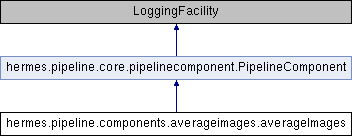|
Hermes DRS
6.0
reduction software
|
Averages images of the stack, deletes the stack and returns an average and its error image. More...

Public Member Functions | |
| def | __init__ |
| Make a Hermes component and initialize variables. | |
| def | optionsAreValid |
| User may give options. | |
| def | __call__ |
| component runs from here | |
 Public Member Functions inherited from hermes.pipeline.core.pipelinecomponent.PipelineComponent Public Member Functions inherited from hermes.pipeline.core.pipelinecomponent.PipelineComponent | |
| def | __init__ |
| def | __call__ |
| def | optionsAreValid |
| def | getOptions |
| def | setOptions |
| def | checkExistShapeUnits |
| def | isOption |
Public Attributes | |
| imageStackTolerance | |
| See if user gave a tolerance, else use default = 4. | |
| isSimpleAverage | |
| User can deactivate this feature and use a "clipped" average instead. | |
| isQualityCheck | |
| User can perform a quality check. | |
| isInputStackKept | |
| General options for program usage. | |
| isDebug | |
| isDebug can generate some intermediary files More... | |
| results | |
 Public Attributes inherited from hermes.pipeline.core.pipelinecomponent.PipelineComponent Public Attributes inherited from hermes.pipeline.core.pipelinecomponent.PipelineComponent | |
| options | |
| logger | |
| ConsoleLogSeverity | |
| default value | |
| canShowGraphics | |
| when machine does not run matplotlib. More... | |
Averages images of the stack, deletes the stack and returns an average and its error image.
PURPOSE :
This module produces either a straightforward or a clipped average (masking
outlying values) of a stack of N single images. In both cases, the variance
of the averaged image due to random noise (read-out and photon noise) is
computed using the default model values for the read-out noise and the gain
factor.
COMMENTS :
The clipping algorithm is based on the estimate of the random noise
standard deviation of the considered pixel multiplied with a tolerance
factor, using an iterative estimation of the intensity of that pixel.
In order to check the assumption that the input images are "identical"
except for random noise, the empirical variance of each pixel is computed
from the scatter in the stack of input images. In the case of "identical"
input images, the distribution of the empirical estimates should agree with
the predictions from the default model values.
No detailed analysis of the correctness of the assumption of "identical"
input images is included (at present), since the most performant tests
depend on the type of differences between input images (such as
shifted spectral orders, varying intensity levels, etc.). Each type of
difference requires (optimally) a test on a different sub-set of pixels.
SYNTAX :
self.results = averageImages(self.results, instrumentModel)
INPUT CONSTANTS FROM INSTRUMENT MODEL :
defaultPrescanBiasADU
biasOffset
defaultReadoutNoiseADU
gain
INPUT DATA FROM RESULTDICT :
A stack of N images in "rawImageStack"
self.results["stackVariance"] = (someValue)
OPTIONS READ FROM OPTIONDICT :
MANDATORY :
OPTIONAL :
"isSimpleAverage"
- True (default)
- False : will perform a "clipped" average (masking outlying values)
any other value executes the option True
while generating an info message.
"isQualityCheck"
- False (default)
- True
any other value executes the option False
while generating an info message.
"isInputStackKept"
- False (default)
- True
the stack of images can usually be removed from memory.
"isDebug"
- False (default)
- True
switch to enable results to be written in fits files.
"imageStackTolerance" default value is 4
#QUESTION: This is unclear to me. Shouldn't we write that
"imageStackTolerance = the tolerance factor for the rejection of
outliers expressed in units of the expected random noise, in this
case set equal to 4", or where can this be found ?
# LD : This is what the manual group should explain,
somewhere in some part of some manual.
OUTPUT :
"self.results.rawImage" : array containing the average of the stack of images
"self.results.rawImageVariance" : array containing the error estimate on "self.results.rawImage"
"self.results.numberOfImagesInStack" : self.results["rawImageStack"].shape[-1]
"self.results.averageImagesInputfilenames" : self.results["FITSFileNames"])
"self.results.isSimpleAverage" = self.isSimpleAverage (option read from optionDict)
Information written to self.results.header includes
averageImagesPixelsMaskedPerFrame, averageImagesStackTolerance,
averageImagesAdd_nStack, averageImagesInputfilenames,
isSimpleAverage
If "isQualityCheck" = True then also write :
An array containing the ratio of the actual variance of the averaged image
(computed from the scatter of the individual frames around the mean) to the
expected variance of the averaged image (computed using the predicted read-out
and random photon noise), in "self.results.isQualityCheck" | hermes.pipeline.components.averageimages.averageImages.isDebug |
isDebug can generate some intermediary files
SHOULD NOT RUN IF 'rawImageStack' not in 'RESULTDICT' ( when a single image is read, it is in 'rawImage' )
 1.8.6
1.8.6